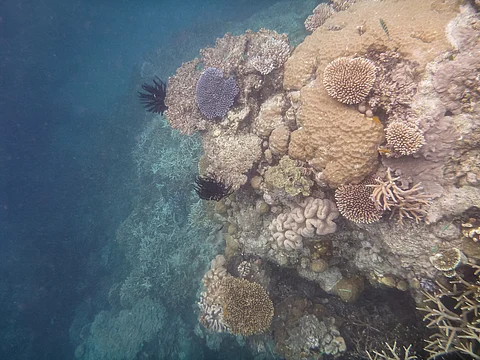

The southern Great Barrier Reef (GBR) saw catastrophic coral bleaching in May 2024, with a staggering 44 per cent mortality rate in protected areas, triggered by heat stress during one of the largest bleaching events recorded.
This mass bleaching event was the result of heat stress caused by the fourth global coral bleaching (GCBE4) event, which began in January 2023. It surpassed the 2014-2017 bleaching levels, with 77 per cent of global reefs experiencing heat-induced stress, pushing the GBR into its fifth-largest widespread bleaching event.
Corals are vital to marine ecosystems, providing habitat for diverse species, food security for coastal populations, and economic value through tourism. Coral bleaching occurs when corals expel the symbiotic algae, zooxanthellae, living within their tissues in response to heat stress, causing the corals to turn white. Though corals can survive bleaching, prolonged stress or rapid changes can lead to death.
Scientists monitored 462 coral colonies at One Tree Reef over a 161-day period, from the peak of heatwaves through to the cooler months of autumn and winter. The peak daily temperature recorded near the colonies was 30.55°C on January 29, while satellite data showed sea surface temperatures reaching 29.13°C on January 30.
The study revealed that by February, 66 per cent of the colonies showed signs of bleaching, and by April, that figure rose to 80 per cent. By May, 44 per cent of the bleached colonies had died, with mortality increasing to 53 per cent by July.
Certain coral genera, particularly Acropora, experienced a staggering 95 per cent mortality rate. Even corals considered thermally resilient, such as Porites, along with anemones, also suffered bleaching. The heat stress weakened the corals, leaving them more vulnerable to diseases related to coral bleaching, further compounding the mortality.
Goniopora corals, for example, developed black band disease (BBD), contributing to the high death toll. Of the 95 per cent of corals that bleached, 66 per cent developed this disease. Acropora colonies saw a 95 per cent mortality rate, mainly due to algal fouling and the collapse of their structures.
Such severe and rapid decline in coral health is unprecedented for this region of the GBR.
Through January and early February, the observed corals began to pale, and by February and April, 66 per cent and 80 per cent of the colonies had bleached. By May, nearly half of the corals that bleached in February were dead, and by July, over half of those that bleached in April had died.
Corals like Acropora, Echinopora, Favites, Isopora, Montipora, Platygyra, Pocillopora, and Seriatopora saw complete bleaching of all their colonies. Other genera, such as Goniastrea and Pavona, were less affected, with 47% and 10% bleaching, respectively. Even Porites corals, which were considered more resilient, experienced 69 per cent bleaching. By July, mortality rates soared, particularly in Isopora and Goniopora colonies, with losses of 63 per cent and 73 per cent, respectively.
As coral colonies collapsed, parts of the reef became rubble. Acropora and Seriatopora showed 95 per cent and 100 per cent mortality rates, respectively, their branches breaking off and forming piles of algae-covered fragments on the seafloor. This destruction marks the beginning of the reef’s structural collapse.
Frequent bleaching events undermine the reef's ability to recover, leading to shifts in species composition and overall ecosystem structure.
This research is crucial for predicting how coral reef ecosystems will evolve in the face of a warming world.
Lead author Maria Byrne emphasised the urgency of action, in a statement which read, “Our findings highlight the need to protect coral reefs, which are vital for biodiversity, food security, and coastal protection. Despite being in protected areas, the southern GBR was not spared from the extreme heat stress that caused this catastrophic bleaching event.”
Professor Ana Vila Concejo, co-author of the study, added that the resilience of coral reefs is being severely tested.
"We must prioritise strategies to help reefs withstand climate change. Our findings call for immediate and effective management to safeguard these ecosystems," she was quoted.